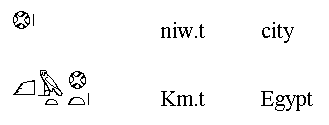
- •Lesson 1 The Egyptian Language and its Script
- •The Ancient Egyptian Language
- •The Hieroglyphic Script
- •Aspects of the Script Orientation of the Signs
- •The Arrangement of Signs
- •The Egyptian Signs
- •Lesson 2 The Egyptian Alphabet - The One-Letter Signs
- •Alternative Writing Forms
- •Exercise: Write Your Own Name in Hieroglyphs
- •Vocabulary
- •Lesson 3 The Egyptian Alphabet Two-Letter Signs and Determinatives
- •Determinative Signs
- •The Number of Nouns
- •Vocabulary
- •Lesson 6 The egyptian numerals The cardinal numbers
- •The dating formula The Egyptian time system
- •The Egyptian dating formula
- •Vocabulary
- •Lesson 7 Linking words together
- •The direct genitival relation
- •The indirect genitival relation
- •The apposition
- •The Common Adjective
- •Attributive Use
- •Substantivated use
- •The Nisbe Adjective
- •Vocabulary
- •27 Мультиязыковой проект Ильи Франка www.Franklang.Ru
Lesson 2 The Egyptian Alphabet - The One-Letter Signs
The One-Letter Signs
As discussed in lesson 1, the ancient Egyptians used literally hundreds of hieroglyphs. The 24 signs introduced in this lesson are the ones that occur most frequently, and are therefore often referred to as the Egyptian alphabet. Each of these signs has the value of one consonant. If you truly want to learn the old-egyptian language, it is essential that you learn these 24 signs by heart.
The table below displays the 24 one-letter signs, together with their meaning, transcription and sound value. Notice that some of the signs have been assigned a vocal value. This is just a convention followed by egyptologists to make the transcribed words more easily pronouncable. The ancient egyptians only wrote the consonantal skeleton of their words, leaving us in the dark about their true pronunciation.
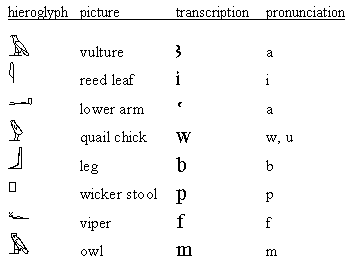
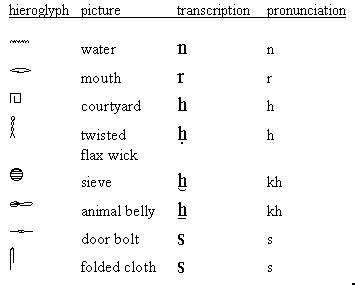
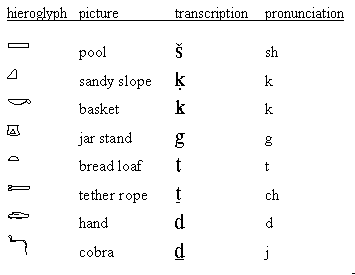
Alternative Writing Forms
A few consonants are sometimes written with alternative signs. The following signs are considered equivalent:
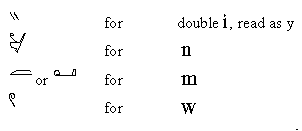
Exercise: Write Your Own Name in Hieroglyphs
A fun exercise is to write your first name in the
script of the ancient Egyptians. Try to duplicate the sound of your
name as much as possible. For the letter v you may use the hieroglyph
for the letter f; for the letter l, use the symbol
![]() .
At the end of your name, you write a male (
.
At the end of your name, you write a male (![]() )
or female (
)
or female (![]() )
sign, depending on your sex.
)
sign, depending on your sex.
To help you get started, we give some examples:
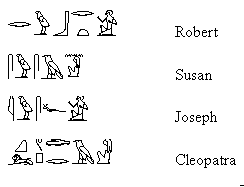
Vocabulary
A number of frequently occurring Egyptian words were written solely with one-letter signs. It is undoubtedly useful to learn some of them.
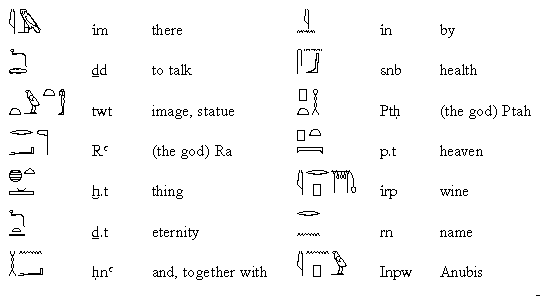
Notice that some words are terminated with a category-determination sign, e.g. in the example with the grape arbor in the word for wine. Such signs are (not unexpectedly) called determinatives. In the next lesson, we'll take a closer look at this type of signs.
Lesson 3 The Egyptian Alphabet Two-Letter Signs and Determinatives
The Two-Letter Signs
Besides the 24 one-letter signs which we discussed in the previous lesson, the old Egyptians also made use of signs with the value of two consonants. These two-letter signs use a single hieroglyph that represents a combination of two consonants.
There exist about a hundred two-letter signs. Fortunately, not all of them occur frequently in texts, and it suffices to be familiar with about 30 of these signs. The table below summarizes the most frequently occurring two-letter signs. It might be a good idea to memorize them.
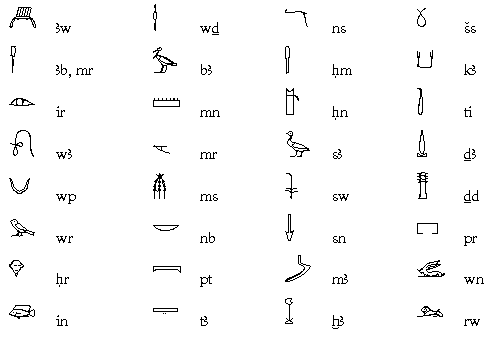
Many of the two-letter signs have meaning on their own, and represent individual words. Often, they are completed with a stroke, the socalled ideogram sign, to indicate that the designated word corresponds with the pictorial value of the sign. Some examples are given below:
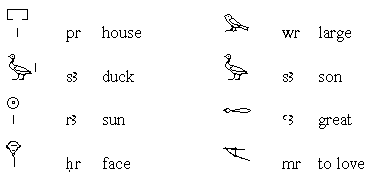
Determinative Signs
Many old Egyptian words are written with the same
signs, even if they have a completely different meaning. To permit an
understanding of the meaning of words, so-called determinative
signs where written at the end of the
word, to help determine the word's meaning. The hieroglyph
![]() e.g.
could be followed by the determinative of a man (
e.g.
could be followed by the determinative of a man (![]() )
to designate the word writer.
The same sign, completed with the determinative of the papyrus roll
(
)
to designate the word writer.
The same sign, completed with the determinative of the papyrus roll
(![]() ),
indicates the word script
or the verb to write.
),
indicates the word script
or the verb to write.
Most determinatives serve to indicate the general category of the word they describe. Below we give a small selection of some of the most common determinative signs:
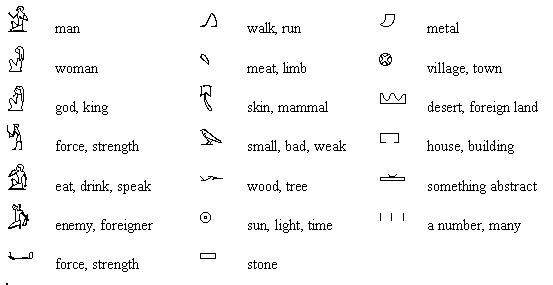
Determinative signs come in handy when attempting to translate an old Egyptian text. The ancient Egyptians had the nasty habit of writing their sentences without spaces between words, and without an indication of the start of new sentences. Because the determinative signs are placed at the end of words, they provide us with a means to decypher the structure of sentences.
Let's take the following sentence as an example:

This sentence consists of the following parts:

This is a verb, with the meaning to leave. Notice the determinative sign with the running legs at the end of the word.
This is the word for majesty, followed by letter f, indicating the possessive pronoun his.
This is an adverb, with the meaning on.
The word for chariot, followed by the possessive pronoun f.
This word indicates a genitive, and can be translated as of.
The word for electron, a mixture of gold and silver.
The word for heart, followed again by the possessive pronoun f.
A word that literally means wide, width. The expression wide of heart can be translated more clearly as his heart full of joy.
The complete sentence can be translated in English as: "His majesty left on his chariot of electron, his heart full of joy".
Vocabulary
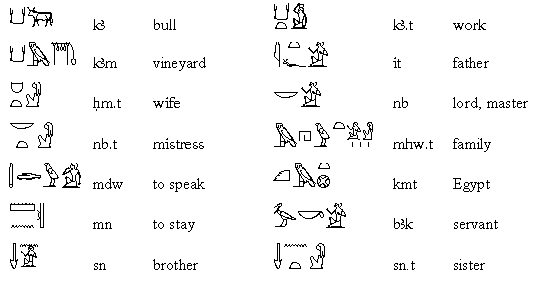
Notice that the list above contains a number of words that use a combination of two- and one-letter signs. We speak of phonetic complements, a matter that will be discussed in more detail in the next lesson.
Lesson 4 The Egyptian Alphabet Three-Letter Signs and Phonetic Complements
The Three-Letter Signs
The ancient Egyptians also used three-letter signs, that represented a combination of three consonants. Most of these signs have meaning on their own, but are also frequently used as sound signs.
There exists a whole range of these three-letter signs. The table below gives an overview of the most common ones.
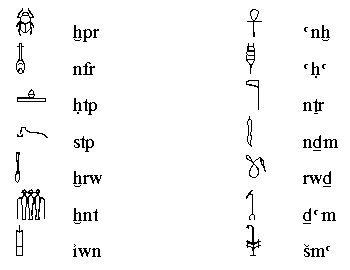
Phonetic Complements
The two- and three-letter signs of the Egyptian script are often complemented with one-letter signs that repeat the whole or part of their sound value. Such additions are called phonetic complements. Usually only the last consonant of the multi-letter sign is repeated. This is however not a fixed rule, and multiple additions are not uncommon.
The table below gives some examples of the use of phonetic complements.

Phonetic complements can be used for a number of reasons. The more common one is that the complementary signs indicate that we have to do with a sound sign (phonogram), and not with a sense sign (ideogram). Furthermore, they can be used to embellish the text, e.g. by filling up unused space (horror vacui).
Inversions
One of the peculiarities of the Egyptian script is the respectful inversion. In words containing the part 'god' or 'king', the sign for the latter is placed in front, out of respect. Note that this involves only the way the word is written, not the way it is pronounced. Some examples are given below.
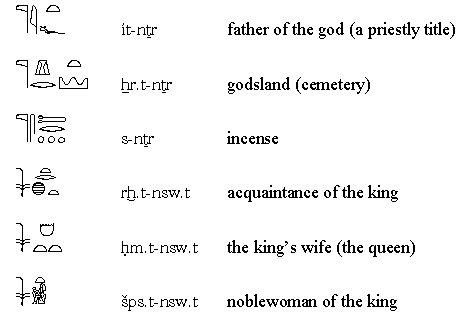
Vocabulary
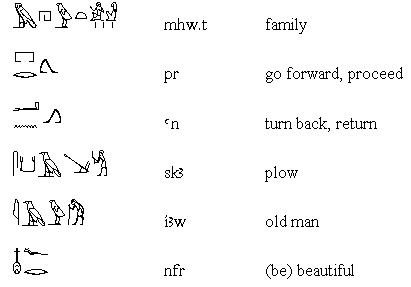
Lesson 5 The noun - gender and number
The Gender of Nouns
Classical Egyptian distinguishes two genders: a
male and a female. Male nouns don't have any specific suffixes to
indicate their gender; they are constructed solely from a number of
consonants that form the word-stem. Female words on the other hand
always end with a "t" (![]() ).
In transcription it is important to write a dot before the "t"
to indicate that the "t"-suffix does not belong to the
word-stem. The "t"-suffix is written before the
determinative or ideogram sign.
).
In transcription it is important to write a dot before the "t"
to indicate that the "t"-suffix does not belong to the
word-stem. The "t"-suffix is written before the
determinative or ideogram sign.

A small number of nouns ends in a "t", but is nevertheless of male gender. In that case the end-t belongs to the word-stem. Below are some examples of such words:
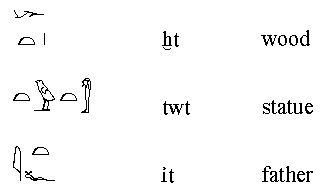
Classical Egyptian doesn't have a neutral gender. It uses the female gender instead. An example follows below:

Names of cities, Egyptian provinces and foreign countries are gramatically of a female gender, whether they end with a "t"-suffix or not. Some examples are:
